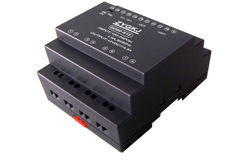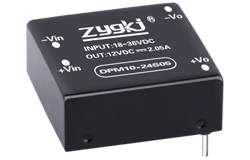nouvelles
Designing an AC-DC Converter Circuit
Auteur: Module d'alimentation ZYG Time: 2023-5-7
AC-DC converter circuits are essential components in many electronic devices such as power supplies and battery chargers. These circuits allow the conversion of AC power from the electrical grid to DC power that can be used to power electronic devices. In this article, we will discuss the design of an AC-DC converter circuit.
The first step in designing an AC-DC converter circuit is to determine the input voltage and the desired output voltage. Once these values are known, the next step is to choose the appropriate transformer and rectifier components.
The transformer is used to step down the input voltage to a level that is suitable for the rectifier circuit. The rectifier circuit is responsible for converting the AC voltage to DC voltage. There are two main types of rectifiers: half-wave and full-wave. The choice of rectifier depends on the specific application and the desired output voltage.
After selecting the appropriate transformer and rectifier components, the next step is to choose the smoothing capacitor. The smoothing capacitor is used to filter out any ripple in the DC voltage. The value of the capacitor depends on the output voltage and the load current.

Once the smoothing capacitor is chosen, the next step is to select the output voltage regulator. The regulator is used to regulate the output voltage to a constant level despite changes in the input voltage or load current. There are several types of voltage regulators, including linear regulators and switching regulators. The choice of regulator depends on the specific application and the desired level of efficiency.
After selecting the voltage regulator, the final step is to choose the output filter. The output filter is used to filter out any remaining high-frequency noise that may be present in the output voltage. The output filter typically consists of a capacitor and an inductor.
In summary, designing an AC-DC converter circuit involves selecting the appropriate transformer, rectifier, smoothing capacitor, voltage regulator, and output filter. The specific components chosen depend on the input and output voltage requirements, the desired level of efficiency, and the specific application.
Précédent: AC-DC Converter Module: Converting Alternating Current to Direct Current
Prochain: Efficient Industrial AC-DC Converter for Reliable Power Conversion
les informations pertinentes
-
2023-5-9
Designing an Efficient Industrial AC-DC Converter
In modern industrial applications, AC-DC converters play a significant role in transforming electrical power between different voltage levels and frequencies. These converters are essential for powering a wide range of devices, from small electronic circuits to heavy machinery. With the increasing demand for more efficient and reliable power supplies, it is essential to design AC-DC converters that can meet the requirements of industrial applications. The efficiency of an AC-DC converter is a critical factor that determines its performance. Higher efficiency means that less power is dissipated as heat, resulting in lower operating temperatures and longer device lifetimes. To achieve high efficiency, designers must consider several factors, including power factor correction, switching frequency, and topology. Power factor correction (PFC) is a...
Voir les détails -
2024-1-3
Exploring the AC/DC 5V Power Supply Module and Its Versatile Applications
The AC/DC 5V Power Supply Module is a crucial component in many electronic devices. It converts the alternating current (AC) from the power source into a direct current (DC) at a stable 5V output. This module plays a vital role in providing power to various electronic circuits and devices such as microcontrollers, sensors, and integrated circuits. Features and Specifications: The AC/DC 5V Power Supply Module comes with several features and specifications that make it highly efficient and reliable. Some of the noteworthy features include: 1. Input Voltage Range: The module is designed to accept a wide range of input voltages, typically ranging from 90V to 240V AC. This allows it to be used with different power sources worldwide. 2. Output...
Voir les détails -
2023-6-27
Bi-Directional DC-DC Converter: A Comprehensive Overview
In recent years, the development of renewable energy sources such as wind and solar power has rapidly increased. However, these sources of energy are intermittent and the output varies depending on the weather condition and time of day. This leads to instability in the power grid. To solve this problem, a bi-directional DC-DC converter is used as a key device to transfer power between the renewable energy source and the power grid. The bi-directional DC-DC converter is a power electronic device that converts DC power from one voltage level to another voltage level. It can transfer power bidirectionally, meaning it can transfer power from the source to the load and vice versa. The converter consists of switches, inductors, capacitors, and...
Voir les détails -
2023-10-13
DC to DC Power Supply Module: An Efficient Solution for Power Conversion
The demand for efficient power conversion solutions has never been higher. As electronic devices become more advanced and power-hungry, it is crucial to find ways to convert power effectively and reliably. One such solution that has gained popularity is the DC to DC power supply module. A DC to DC power supply module is a compact electronic device that converts one DC voltage level to another, efficiently transferring power from a source to a load. This module plays a vital role in many applications, including telecommunications, automotive electronics, industrial equipment, and renewable energy systems. One of the primary advantages of using a DC to DC power supply module is its high efficiency. Traditional linear voltage regulators can waste a significant...
Voir les détails -
2023-8-5
AC/DC Power Supply Module: Providing Reliable Electrical Power for Various Applications
Introduction In the modern world, reliable electrical power is essential for the smooth functioning of various applications. From electronic devices to industrial machinery, a stable power supply is crucial to ensure optimal performance and prevent damage due to voltage fluctuations. This is where the AC/DC Power Supply Module comes into play. Designed with precision and efficiency in mind, this module is a reliable solution for meeting the power requirements of diverse applications. Understanding the AC/DC Power Supply Module The AC/DC Power Supply Module is a compact electronic device that converts the alternating current (AC) power from a wall outlet into direct current (DC) power suitable for powering electronic components. It operates on the principle of electromagnetic induction and employs various...
Voir les détails -
2023-6-8
Bidirectional DC DC Converter: A Solution for Efficient Power Conversion in Renewable Energy Systems
As the world is moving towards sustainable energy sources, renewable energy systems are gaining immense popularity. However, the energy produced by these systems is often variable and unpredictable, making it challenging to integrate them into the existing power grids. To overcome this challenge, a bidirectional DC-DC converter has emerged as a promising solution. This article discusses the bidirectional DC-DC converter and its role in efficient power conversion in renewable energy systems. What is a Bidirectional DC-DC Converter? A bidirectional DC-DC converter is a power electronics device that can convert the direct current (DC) voltage from one level to another by switching between the input and output voltages. It can work in both directions, i.e., it can convert the energy from...
Voir les détails


















